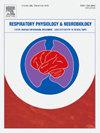心肺疾病患者运动性呼吸困难的病理生理机制:最新进展
IF 1.6
4区 医学
Q3 PHYSIOLOGY
引用次数: 0
摘要
体力活动是慢性心肺疾病呼吸困难的主要诱因。最近,人们对揭示这种令人痛苦的症状背后的机制重新产生了兴趣。我们首先阐明一个概念框架,将心肺异常与运动期间不良呼吸感觉的中枢知觉联系起来。我们特别强调,用力性呼吸困难最终反映了(高)需求和(低)容量之间的不平衡。因此,该症状出现在吸气神经驱动(呼吸意志)增强的情况下,继发于:a)相对于瞬时通气量增加的通气量输出(呼吸过度)和/或b)由于潮汐容积扩张受限(呼吸受限),其转化为呼吸行为受阻。在慢性阻塞性肺疾病(COPD)、哮喘、囊性纤维化和间质性肺疾病(ILD)患者中,随着疾病的进展,呼吸受限的作用越来越明显。在慢性阻塞性肺病的初始阶段,由于生理死腔中浪费的通气增加而导致的过度呼吸尤为重要,而肺泡过度通气在低氧血症的ILD患者中起主要作用。过度换气也是心力衰竭(HF)伴射血分数降低(EF)时呼吸困难的主要驱动因素,而高生理性死亡空间是心力衰竭伴射血分数保留的主要潜在机制。同样,在肺血管疾病中,肺组织灌注不良导致的通气浪费占主导地位。新的基于人工智能的方法来揭示过度和受限呼吸的贡献,可能会提高心肺运动试验在调查这些患者的用力性呼吸困难中的产量。本文章由计算机程序翻译,如有差异,请以英文原文为准。
Pathophysiological mechanisms of exertional dyspnea in people with cardiopulmonary disease: Recent advances
Physical activity is a leading trigger of dyspnea in chronic cardiopulmonary diseases. Recently, there has been a renewed interest in uncovering the mechanisms underlying this distressing symptom. We start by articulating a conceptual framework linking cardiorespiratory abnormalities with the central perception of undesirable respiratory sensations during exercise. We specifically emphasize that exertional dyspnea ultimately reflects an imbalance between (high) demand and (low) capacity. As such, the symptom arises in the presence of a heightened inspiratory neural drive – the will to breathe – secondary to a) increased ventilatory output relative to the instantaneous ventilatory capacity (excessive breathing) and/or b) its impeded translation into the act of breathing due to constraints on tidal volume expansion (constrained breathing). In patients with chronic obstructive pulmonary disease (COPD), asthma, cystic fibrosis, and interstitial lung disease (ILD), constrained breathing assumes a more dominant role as the disease progresses. Excessive breathing due to heightened wasted ventilation in the physiological dead space is particularly important in the initial stages of COPD, while alveolar hyperventilation has a major contributory role in hypoxemic patients with ILD. Hyperventilation is also a leading driver of dyspnea in heart failure (HF) with reduced ejection fraction (EF), while high physiological dead space is the main underlying mechanism in HF with preserved EF. Similarly, wasted ventilation in poorly perfused lung tissue dominates the scene in pulmonary vascular disease. New artificial intelligence-based approaches to expose the contribution of excessive and constrained breathing may enhance the yield of cardiopulmonary exercise testing in investigating exertional dyspnea in these patients.
求助全文
通过发布文献求助,成功后即可免费获取论文全文。
去求助
来源期刊
CiteScore
4.80
自引率
8.70%
发文量
104
审稿时长
54 days
期刊介绍:
Respiratory Physiology & Neurobiology (RESPNB) publishes original articles and invited reviews concerning physiology and pathophysiology of respiration in its broadest sense.
Although a special focus is on topics in neurobiology, high quality papers in respiratory molecular and cellular biology are also welcome, as are high-quality papers in traditional areas, such as:
-Mechanics of breathing-
Gas exchange and acid-base balance-
Respiration at rest and exercise-
Respiration in unusual conditions, like high or low pressure or changes of temperature, low ambient oxygen-
Embryonic and adult respiration-
Comparative respiratory physiology.
Papers on clinical aspects, original methods, as well as theoretical papers are also considered as long as they foster the understanding of respiratory physiology and pathophysiology.

 求助内容:
求助内容: 应助结果提醒方式:
应助结果提醒方式:


